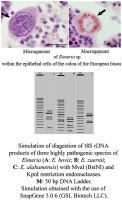当前位置:
X-MOL 学术
›
Int. J. Parasitol. Parasites Wildl.
›
论文详情
Our official English website, www.x-mol.net, welcomes your
feedback! (Note: you will need to create a separate account there.)
Usefulness of PCR-RFLP of 18S rRNA gene for rapid post-mortem diagnostics of highly pathogenic Eimeria spp. (Apicomplexa: Eimeriidae) of European bison, Bison bonasus L. with histopathological correlation.
International Journal for Parasitology: Parasites and Wildlife ( IF 2.0 ) Pub Date : 2020-04-03 , DOI: 10.1016/j.ijppaw.2020.03.008 Anna M Pyziel 1 , Aleksander W Demiaszkiewicz 2 , Barbara Osińska 3 , Izabella Dolka 3 , Krzysztof Anusz 1 , Zdzisław Laskowski 2
International Journal for Parasitology: Parasites and Wildlife ( IF 2.0 ) Pub Date : 2020-04-03 , DOI: 10.1016/j.ijppaw.2020.03.008 Anna M Pyziel 1 , Aleksander W Demiaszkiewicz 2 , Barbara Osińska 3 , Izabella Dolka 3 , Krzysztof Anusz 1 , Zdzisław Laskowski 2
Affiliation

|
Eimeria spp. infection was investigated in 10 free-roaming European bison aged three months to 26 years by anatomopathological, histopathological, coproscopic and PCR-RFLP examination. The coproscopic study identified Eimeria oocysts in the faeces of five bison. The most prevalent morphotypes were E. bovis, present in all positive samples, and E. zuernii, in all but one. Additionally, mixed infections consisting of E. bovis, E. zuernii, E. alabamensis, E. auburnensis, E. canadensis, E. cylindrica, E. ellipsoidalis and E. subspherica were diagnosed in two bison calves. Besides being the most prevalent form, E. bovis also demonstrated the highest OPG (2,750). The presence of oocysts in the faeces was associated with those of macrogamonts, microgamonts and oocysts in the epithelium of the large intestine. Intestinal coccidiosis associated with lymphoplasmacytic enteritis was observed in many bison, not only those with positive OPG. Four animals with negative coproscopy results demonstrated early-stage gametogony in the large intestine; one case presented no endogenous stages of coccidians in the histopathological sections of the intestine, nor oocysts in the faecal samples. A 530 bp product of E. bovis 18S rDNA (GenBank: MK951685) was obtained from both the colon wall and oocysts; this was subjected to PCR-RFLP analysis based on AluI and Hin1II (NlaIII) restriction enzymes. Both samples yielded a consistent seven-band pattern, four of which (270 bp, 40 bp, 180 bp and 84 bp) were expected, and the other three represented undigested fragments. The obtained digestion pattern is indicative of Eimeria spp. infection, and can serve as a first-step diagnostic approach in detection of infection. The result of computer-based virtual digestion of the PCR product suggests that double digestion with Mval (BstNI) and KpnI restriction enzymes may be used as a second-step tool to distinguish between E. bovis, E. zuernii and E. alabamensis, all of which are highly-pathogenic species.
中文翻译:

18S rRNA 基因 PCR-RFLP 在高致病性艾美耳球虫快速尸检诊断中的用途。欧洲野牛(Bison bonasus L.)(顶复门:艾美耳科)具有组织病理学相关性。
艾美耳球虫属通过解剖病理学、组织病理学、粪便镜和 PCR-RFLP 检查,对 10 只年龄为 3 个月至 26 岁的自由漫游欧洲野牛进行了感染调查。尸检研究在五头野牛的粪便中发现了艾美耳球虫卵囊。最常见的形态型是 E. bovis,存在于所有阳性样本中;E. zuernii,存在于除一个样本之外的所有样本中。此外,在两只小野牛中还诊断出了由牛艾美耳球虫、祖尔尼艾美耳球虫、阿拉巴马艾美耳球虫、奥本艾美耳球虫、加拿大艾美耳球虫、圆柱艾美耳球虫、椭圆体艾美耳球虫和亚球形艾美耳球虫组成的混合感染。除了是最普遍的形式外,牛大肠杆菌还表现出最高的 OPG(2,750)。粪便中卵囊的存在与大配子体、小配子体和大肠上皮中的卵囊有关。在许多野牛中观察到与淋巴浆细胞性肠炎相关的肠道球虫病,而不仅仅是 OPG 阳性的野牛。四只粪便镜检结果呈阴性的动物显示出大肠的早期配子发育;一个病例在肠道组织病理学切片中未发现内源性球虫阶段,粪便样本中也未发现卵囊。从结肠壁和卵囊中获得 530 bp 的牛大肠杆菌 18S rDNA(GenBank:MK951685)产物;对其进行基于 AluI 和 Hin1II (NlaIII) 限制性酶的 PCR-RFLP 分析。两个样品均产生一致的七带模式,其中四个(270 bp、40 bp、180 bp 和 84 bp)是预期的,另外三个代表未消化的片段。获得的消化模式表明艾美耳球虫属。感染,并且可以作为检测感染的第一步诊断方法。 PCR 产物基于计算机的虚拟消化结果表明,用 Mval (BstNI) 和 KpnI 限制性内切酶进行双重消化可用作区分牛艾美耳球菌、祖尔尼艾美耳球菌和阿拉巴马艾美耳球菌的第二步工具。其中属于高致病性物种。
更新日期:2020-04-03
中文翻译:

18S rRNA 基因 PCR-RFLP 在高致病性艾美耳球虫快速尸检诊断中的用途。欧洲野牛(Bison bonasus L.)(顶复门:艾美耳科)具有组织病理学相关性。
艾美耳球虫属通过解剖病理学、组织病理学、粪便镜和 PCR-RFLP 检查,对 10 只年龄为 3 个月至 26 岁的自由漫游欧洲野牛进行了感染调查。尸检研究在五头野牛的粪便中发现了艾美耳球虫卵囊。最常见的形态型是 E. bovis,存在于所有阳性样本中;E. zuernii,存在于除一个样本之外的所有样本中。此外,在两只小野牛中还诊断出了由牛艾美耳球虫、祖尔尼艾美耳球虫、阿拉巴马艾美耳球虫、奥本艾美耳球虫、加拿大艾美耳球虫、圆柱艾美耳球虫、椭圆体艾美耳球虫和亚球形艾美耳球虫组成的混合感染。除了是最普遍的形式外,牛大肠杆菌还表现出最高的 OPG(2,750)。粪便中卵囊的存在与大配子体、小配子体和大肠上皮中的卵囊有关。在许多野牛中观察到与淋巴浆细胞性肠炎相关的肠道球虫病,而不仅仅是 OPG 阳性的野牛。四只粪便镜检结果呈阴性的动物显示出大肠的早期配子发育;一个病例在肠道组织病理学切片中未发现内源性球虫阶段,粪便样本中也未发现卵囊。从结肠壁和卵囊中获得 530 bp 的牛大肠杆菌 18S rDNA(GenBank:MK951685)产物;对其进行基于 AluI 和 Hin1II (NlaIII) 限制性酶的 PCR-RFLP 分析。两个样品均产生一致的七带模式,其中四个(270 bp、40 bp、180 bp 和 84 bp)是预期的,另外三个代表未消化的片段。获得的消化模式表明艾美耳球虫属。感染,并且可以作为检测感染的第一步诊断方法。 PCR 产物基于计算机的虚拟消化结果表明,用 Mval (BstNI) 和 KpnI 限制性内切酶进行双重消化可用作区分牛艾美耳球菌、祖尔尼艾美耳球菌和阿拉巴马艾美耳球菌的第二步工具。其中属于高致病性物种。











































 京公网安备 11010802027423号
京公网安备 11010802027423号